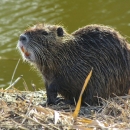Visit Us
National wildlife refuges offer us all a chance to unplug from the stresses of daily life and reconnect with our natural surroundings. Santee NWR offers both outdoor recreation pursuits and opportunities to learn about our cultural history. Make Santee NWR your destination to see wildlife, hike and bike, hunt, fish and enjoy boating. Visit the historic Santee Indian mound which was used as a British Garrison during the Revolutionary War.
The Visitor Center is open Tuesday through Friday from 8:00 am - 4:00 pm. Most refuge trails and grounds are open sunrise to sunset. At the Center, pick up refuge maps and brochures before heading out onto the trails. Forget your binoculars and field guides? No worries. Pick up a "loaner" backpack that has binoculars and guides you can use while you explore and enjoy the refuge.
Location and Contact Information
About Us
Santee NWR was established to benefit migratory waterfowl, other birds, and terrestrial and aquatic wildife found within the ecosystem of the Lake Marion reservoir. Throughout the year, a myriad of wildlife species inhabit the diverse landscapes of the refuge that include a rare Carolina Bay. Santee NWR employs many conservation measures to support wildlife and habitats and, works with partners and organizations to create and promote outdoor recreational opportunities that benefit wildlife and people.
What We Do
With the diversity of wildlife and habitats at Santee NWR, multiple management efforts are underway throughout the year. Water levels are adjusted as needed to benefit wildlife and native vegetation and to control invasive species invasive species
An invasive species is any plant or animal that has spread or been introduced into a new area where they are, or could, cause harm to the environment, economy, or human, animal, or plant health. Their unwelcome presence can destroy ecosystems and cost millions of dollars.
Learn more about invasive species . Banding programs for wood ducks and other birds are implemented to monitor and manage populations. Agricultural crops are planted in fields to attract a variety of species, and forests are maintained by prescribed fire and mowing.
The refuge works with state and county agencies, local businesses and organizations to ensure recreational hunting and fishing opportunities that help maintain healthy wildlife populations on the refuge and within the greater Lake Marion reservoir area.
Nearly 40 miles of maintained trails can be found on the refuge for visitors to enjoy. Over 10 miles are for hiking and 13 miles for both hiking and bicycling. The 7.5 mile auto tour route offers opportunities for seeing many wildlife species and beautiful landscape views.
Of significant cultural value is the 1200 year old Santee Indian Mound-Fort Watson historical site, listed in the National Register oif Historic Places and protected by the refuge.
Our Organization
Santee NWR, with its forest and wetlands sustaining diverse wildlife and fish species, works collectively with agencies, organizations and individuals to support conservation programs in keeping with the mission of the National Wildlife Refuge System and this refuge. Programs are undertaken to enhance habitat, wildlife and fish populations, migratory birds, and preserve the historic and cultural sites at the refuge.
Our Species
Santee NWR is a great place to get outdoors and get immersed in the natural world around you. Visitors come to Santee NWR in anticipation of seeing wildlife here on the refuge. The diverse habitats on the refuge support many kinds of wildlife. The refuge is home to nearly 300 bird species, more than 100 species of fish, 50 mammals species, 54 reptile species and 35 amphibian species. The forest provides a home for white-tailed deer and other woodland creatures, such as raccoons, squirrels, and bobcats. The ponds and marshes provide a home for alligators and a number of other reptiles, and amphibians such as the spotted salamander. You may see the federally threatened wood stork, as well as bald eagles and wood ducks.
Our Library
Our library is a repository of published documents that are relevant to the programs and management activities at Santee National Wildlife Refuge and the U.S. Fish and Wildlife Service. These documents provide information for what is undertaken at Santee NWR and the Service to protect, enhance and maintain our natural and cultural resources.
Get Involved
Whether you want to further conservation, learn more about nature or share your love of the outdoors, you’ve come to the right place. National wildlife refuges provide many opportunities for you to help your community and fish and wildlife by doing what you love. National wildlife refuges partner with volunteers, youth groups, landowners, neighbors and residents of urban and coastal communities to make a lasting difference. Find out how you can help make American lands healthier and communities stronger while doing something personally satisfying.
We welcome you at Santee NWR! If you would like to learn more about how you can get involved with Santee NWR, please contact Monica Williams, Refuge Manager, at (803) 478-2217 or email monica_williams@fws.gov
Projects and Research
Collaborative partnerships with state and county resource agencies, colleges and private landowners provide opportunities to support habitat enhancement and wildlife populations.
Contracted farming, silviculture, bird surveys and banding, invasive species invasive species
An invasive species is any plant or animal that has spread or been introduced into a new area where they are, or could, cause harm to the environment, economy, or human, animal, or plant health. Their unwelcome presence can destroy ecosystems and cost millions of dollars.
Learn more about invasive species control, plant and wildlife projects and research and, on-going biological studies of targeted species such as bats and swallows occur annually on the refuge.

















